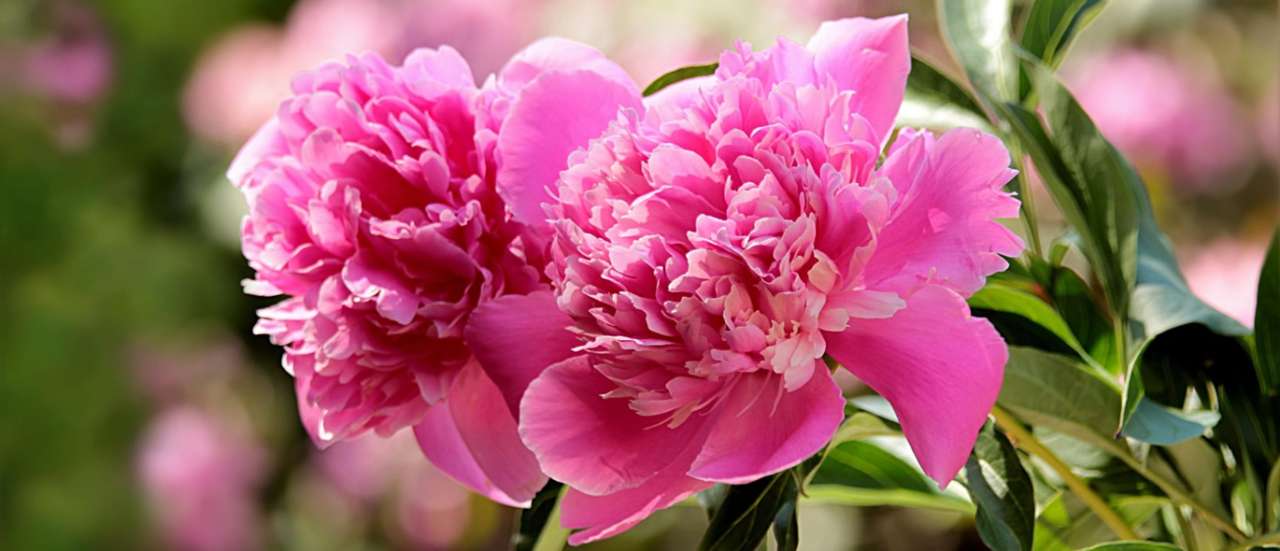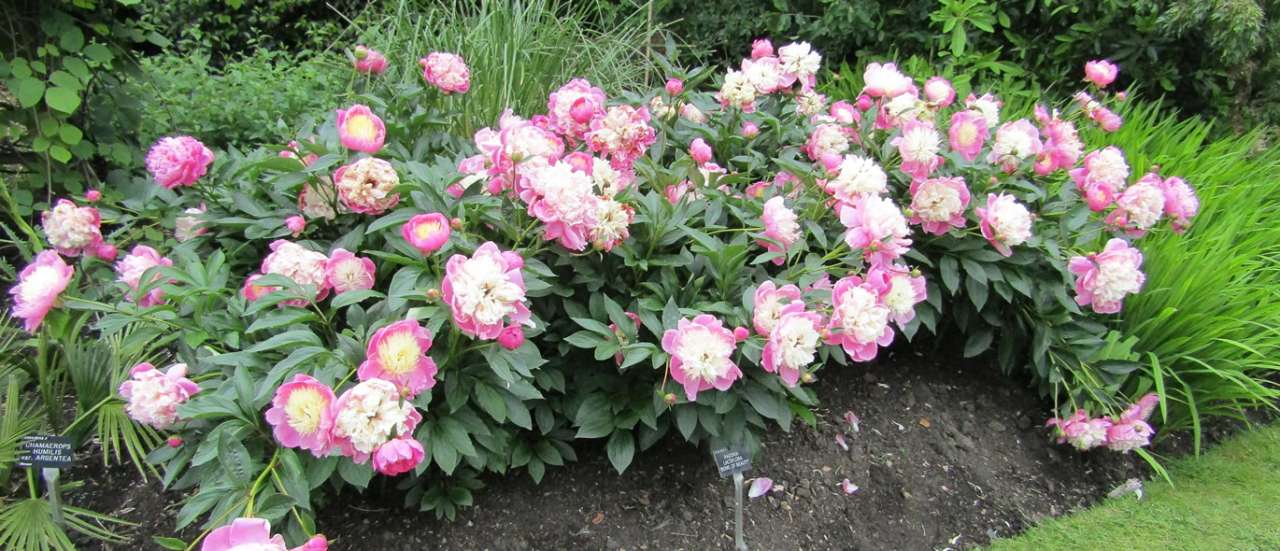Peonies are considered one of the showiest plants to have in your garden and are particularly revered by the Japanese, symbolising wealth, honor and nobility. There are three types of peony:
- Herbaceous Peonies - like other herbaceous perennials these will die back to the ground each winter with foliage emerging again the following spring;
- Tree Peonies - these are in fact small shrubs which don't die back in winter but rather they lose their foliage, as with any deciduous shrub, whilst keeping their woody frame;
- Intersectional peonies - these are sometimes referred to as intermediate or 'Itoh' peonies and are a cross between a tree peony and a herbaceous peony. They are grown in the same way as a herbaceous peony but they tend to flower for much longer (around 3-4 weeks longer) as they have so many more buds.
Flowers range in colour from white through various shades of pink to dark red and yellow. Intersectional peonies may also come in apricot and purple shades. The flowers themselves are usually quite large, can be single, semi-double or double and often appear to have a bowl shape, although there are a few varieties that have an anemone form that opens to a flatter, rippled petal structure.
Peonies are quite large plants and will require a good square metre of soil space to grow in so this is something to bare in mind with regards to positioning. The great thing about these show-stoppers is that they are fully hardy and don't require winter protection, so they are perfect for growing in Ireland and adding some flamboyance to your beds and borders.
 Image by Christiane from Pixabay
Image by Christiane from Pixabay
Where and How to grow:
All peonies are best planted in spring or autumn as this should allow enough moisture in the soil for them to become established with very little aftercare. If you are planting in the summer, be sure to water in dry periods and prevent the soil from completely drying out. It's a good idea to have your peonies in a fairly sheltered position away from strong winds if you want to maintain the blooms on the plant for longer and prevent leaf damage.
Herbaceous and intersectional peonies will thrive in a rich fertile soil in full sun, preferring a neutral to alkaline soil. Tree peonies are more able to tolerate dappled shade and whilst they like a neutral soil, they will be fine in a slightly acidic or alkaline soil. Extremes of acidity or alkalinity will not be suitable for tree peonies however. (If you are unsure about the pH levels of your soil, it is always a good idea to conduct a simple pH test using one of a variety of inexpensive kits or pH meters that are available. This simple and inexpensive test only needs to be done once, testing various spots in your garden for consistency and can save you a great deal of financial loss and heartbreak in your future gardening exploits.)
One of the key things to remember with peonies is that, whist they will grow in most soil types, including clay, they will not put up with being waterlogged in winter and too dry in the summer. A moist but well draining soil is ideal.
If planted correctly there is very little to do in terms of maintenance. Follow these steps when planting and you should have happy and productive peonies providing beautiful blooms in the garden for a lifetime:
- Prepare your soil - Before planting it is a good idea to dig in a fair amount of organic matter (compost or well-rotted manure), preparing an area of about a metre squared.
- Once you have your soil prepared, dig a hole that is twice as wide as the pot your plant came in, if you have clay soil, you may want to add a good amount of horticultural grit just to improve drainage and ensure that the roots of your peony are not sitting in waterlogged soil. These are relatively expensive perennials and the last thing you want is for them to rot because you missed this crucial step.
- One of the most common mistakes to make with herbaceous and intermediate peonies, is to plant them too deep. Ensure the bright red, newly developing buds have no more than an inch of soil above them as this can reduce flowering. If in doubt plant no deeper than the level the plant was at, in the pot you bought it in.
- If you are planting a tree peony however, these are usually grafted on to a herbaceous root-stock and so you want to find where the graft union is and ensure this is planted about 6 inches below the soil level. This encourages the grafted plant to grow its own roots..
- Once you've positioned your plant at the correct level, you can then start to backfill the hole, gently firming in the soil around the plant, then give it a good watering.
- Ideally you should add a layer of mulch around the plant, being sure to leave an area free around the stems (especially with tree peonies) to prevent rot. It's also a good idea with herbaceous peonies to have some kind of support in place for the plant to grow into. A half moon or rounded support is ideal.
Peony care:
For the first year you just need to ensure that you water them during particularly dry spells, especially if planting in late spring or summer. In following years you shouldn't need to keep up any watering regime as peonies are deep rooting and will draw their own moisture.
In terms of feeding, a general purpose feed once per year in the spring should suffice to promote good leaf growth and encourage more flowers. You can then add a layer of mulch to contain moisture, again, ensuring that you leave the immediate area of the plant free from mulch so as not to bury the buds any further or, in the case of tree peonies, to prevent rot around the stem.
As for pruning, for tree peonies you can just cut back the stems of spent flowers just above the new growth on the stem in summer. Remove any dead shoots in late winter by cutting back to a healthy bud. If your plant starts to become leggy, which can take a few years, you can cut them back by about a third, once the leaves have fallen in autumn, and this will encourage bushier growth the following year.
For herbaceous peonies you just cut these back to ground level in autumn once the foliage starts dying back.
 Photo by Leonora (Ellie) Enking (CC BY-SA 2.0)
Photo by Leonora (Ellie) Enking (CC BY-SA 2.0)
Propagation:
After a few years, herbaceous peonies can be propagated by division in the autumn. Peonies don't generally like being moved and so this is best left until you notice that there is a considerable decline in flowering which indicates that the clumps are becoming too crowded, This is when division becomes beneficial to promote better future performance. When dividing, make sure that each section contains at least three dormant buds and good section of root and replant immediately as you would a new plant.
Tree peonies can be grown from seed but this can be quite complicated so often new peonies are propagated by layering. This can be done by burying a section of a flexible stem underground and leaving it to root. It can take 2-3 years before the roots formed are sufficient enough to separate the new section from the parent plant.
To conclude then, peonies are an excellent addition to any garden and as long as you get the initial position and planting right, they'll provide you with an outstanding summer display of large showy flowers for decades. If this sounds like the exact kind of plant you are looking for, then check out or range online or pop into one of our stores in Roscommon Town or Boyle. Remember, if you are looking for a particular variety that you don't see stocked here, please get in touch and we'll do our best to source it for you.
Cover Image by Michelle Raponi from Pixabay








